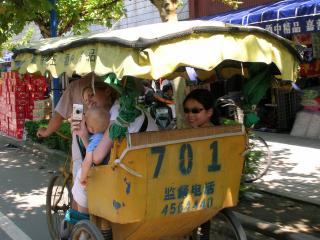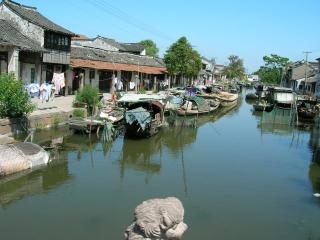Shanghai China: On a Slow Boat
Forget SARS, Avian Bird Flu or even death by Drunken Noodle. What we fear might kill us in China is the traffic, both in the car and as a pedestrian! We’ve crammed more into 24 hours in China than it feels like we did in the past two weeks! Monday we arrived at Shanghai’s Pudong International Airport and were greeted by our friend Kara’s brother Tom and his wife Andrea. Tom and Andrea are from Vancouver Washington and Boise Idaho, respectively, but they’ve lived in Shanghai for the past seven years and navigate the language, city and cars like locals. They and their adorable baby Roger (15 months old) are helping us get acclimated not only to Shanghai but to China. After getting settled into our 1 bedroom apartment at the World Union, a serviced apartment building (our room is costing us a cool 600 yuan per night—about $75—but that comes with a washer and dryer, kitchen, TV, DVD player, sporadic maid service and a fantastic location—not a bad deal), we headed for some dim sum a short drive away. We savored bao, fried wontons, shrimp dumplings, noodles, and more dishes than I can remember. Dylan’s comment was that it was the best Chinese food she’s ever eaten, which is kind of funny since she’s really getting it from China! After a great dinner and fun visit, we made plans to get together in the morning with Andrea and her mom Priscilla (who is visiting). Andrea had reserved a van and private driver so that we could go visit a small town in the country.
Shanghai is just across the East China Sea from Japan and Korea and is a city split east and west by the Huangpu River. Lakes and canals frame the outlaying areas, and through many searches on the internet and her own research, Andrea found a small “authentic” canal town, as opposed to the more popular touristed towns with canals like Suzhou, all of which bill themselves the Venice of the Orient. We were all set to go, but first we had to get there. This was the first time Andy, Dylan and I have really experienced third world traffic, and at moments we felt not only exhiliaration, but sheer terror. Not used to the constant honking, cars using lane markers as mere suggestions rather than rules, and seeing the shoulder of the freeway used as a third lane, we couldn’t stop shaking our head in disbelief. But it wasn’t until we got off the freeway and started driving the rural roads, that we looked at each other and said, well Toto, we’re not in Portland anymore! About an hour on the road, our driver started stopping people and asking them for directions to get us closer to the town we wanted to see. This didn’t seem to be a problem until he would stop in the middle of the left side of a narrow 2-lane road and a truck would be bearing down on us. Add the fact that the road was half ripped up (or perhaps it was half newly finished), and drivers were weaving in and out on one lane, avoiding the man pouring hot tar to seal the new concrete joints out of his teakettle, and we knew that no matter what greeted us at the end, the journey was already worth writing home about. We must note that we did not have seat belts, which is not unusual for cars anywhere outside of the U.S.
Once we arrived in the small town (I hate to give the name away, it’s not in the Lonely Planet, and it’s such a find), we bid farewell to the driver for the rest of the afternoon and went in search of a bathroom. But first we walked through a large building housing a market that had tubs of snakes, crabs, fish and frogs, trying to make their escape from certain death; butchers with chopped up pieces of what I can only guess were pigs, tons of vegetables and counters topped with huge bags of loose teas and jars of pickled vegetables. Dylan was freaking out about the smells (I didn’t show her the snakes), and we got our first glimpse of what a celebrity baby Roger is in China (with his blond hair and big eyes, riding in a high-tech backpack, he’s like a magnet for all the older people in the area).

After finding the bathrooms (essentially tiled troughs in the ground which we had to pay a cool 4 cents to use), we hired bicycle rickshaws to take us to the canals.

The canals, the 500 year old bridge(s) crossing them and the rows of tiny houses, beautiful, yet simple and so poor inside—it’s hard to believe that these same smiling people live in them—were just amazing.


We ducked into tiny courtyards that surprised us with amazing artwork and statues, shopped for some souvenirs that may have been created by the person who was selling them, and had a yummy lunch by the canal, then took a boat trip along one of the main waterways.

After wandering around the town for a few hours, we found different rickshaw drivers to carry us back to the van and started our 2+ hour journey back to Shanghai. Back in Shanghai , the three of us bid farewell to Andrea and her mom, with plans to meet up the next day on the Bund to explore the fabric market. We went out to dinner to the same place we went the night before, but to do that we had to walk there. This is when we started fearing for our lives as pedestrians. After a few scary crossings, dodging cars, bikes and scooters (the walk sign was on for us!!) we were determined to take a taxi back because Dylan was a inch from being killed and did not want to cross another street in Asia, but after waiting 20 minutes for an empty one to pass us, we gave up and walked back to our place, where we ended a well-traveled day.
Shanghai is just across the East China Sea from Japan and Korea and is a city split east and west by the Huangpu River. Lakes and canals frame the outlaying areas, and through many searches on the internet and her own research, Andrea found a small “authentic” canal town, as opposed to the more popular touristed towns with canals like Suzhou, all of which bill themselves the Venice of the Orient. We were all set to go, but first we had to get there. This was the first time Andy, Dylan and I have really experienced third world traffic, and at moments we felt not only exhiliaration, but sheer terror. Not used to the constant honking, cars using lane markers as mere suggestions rather than rules, and seeing the shoulder of the freeway used as a third lane, we couldn’t stop shaking our head in disbelief. But it wasn’t until we got off the freeway and started driving the rural roads, that we looked at each other and said, well Toto, we’re not in Portland anymore! About an hour on the road, our driver started stopping people and asking them for directions to get us closer to the town we wanted to see. This didn’t seem to be a problem until he would stop in the middle of the left side of a narrow 2-lane road and a truck would be bearing down on us. Add the fact that the road was half ripped up (or perhaps it was half newly finished), and drivers were weaving in and out on one lane, avoiding the man pouring hot tar to seal the new concrete joints out of his teakettle, and we knew that no matter what greeted us at the end, the journey was already worth writing home about. We must note that we did not have seat belts, which is not unusual for cars anywhere outside of the U.S.
Once we arrived in the small town (I hate to give the name away, it’s not in the Lonely Planet, and it’s such a find), we bid farewell to the driver for the rest of the afternoon and went in search of a bathroom. But first we walked through a large building housing a market that had tubs of snakes, crabs, fish and frogs, trying to make their escape from certain death; butchers with chopped up pieces of what I can only guess were pigs, tons of vegetables and counters topped with huge bags of loose teas and jars of pickled vegetables. Dylan was freaking out about the smells (I didn’t show her the snakes), and we got our first glimpse of what a celebrity baby Roger is in China (with his blond hair and big eyes, riding in a high-tech backpack, he’s like a magnet for all the older people in the area).

After finding the bathrooms (essentially tiled troughs in the ground which we had to pay a cool 4 cents to use), we hired bicycle rickshaws to take us to the canals.

The canals, the 500 year old bridge(s) crossing them and the rows of tiny houses, beautiful, yet simple and so poor inside—it’s hard to believe that these same smiling people live in them—were just amazing.


We ducked into tiny courtyards that surprised us with amazing artwork and statues, shopped for some souvenirs that may have been created by the person who was selling them, and had a yummy lunch by the canal, then took a boat trip along one of the main waterways.

After wandering around the town for a few hours, we found different rickshaw drivers to carry us back to the van and started our 2+ hour journey back to Shanghai. Back in Shanghai , the three of us bid farewell to Andrea and her mom, with plans to meet up the next day on the Bund to explore the fabric market. We went out to dinner to the same place we went the night before, but to do that we had to walk there. This is when we started fearing for our lives as pedestrians. After a few scary crossings, dodging cars, bikes and scooters (the walk sign was on for us!!) we were determined to take a taxi back because Dylan was a inch from being killed and did not want to cross another street in Asia, but after waiting 20 minutes for an empty one to pass us, we gave up and walked back to our place, where we ended a well-traveled day.

1 Comments:
Just got caught up on your adventures! We are back into the school routine in Portland...you'll remember the drill. We're thinking of you!! Hank, Meg, Maggie and Ben
Post a Comment
<< Home